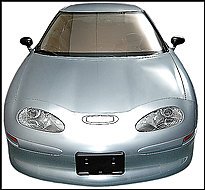"An Electric Car, Booted"

The premise of the film "Who Killed the Electric Car" makes you shake your head and wonder which idiots took these cars off the road, cancelled the program and set the United States down the road of foreign-oil dependence. One doesn't have to be rocket scientist to guess that the big oil and car companies and their satellites, some of whom are foreign governments, influenced the demise of the electric care and created the energy and political quagmire in which we find ourselves today. I hate to say it: the authors of this decision are guilty of gross stupidity and perhaps, treason.
The film chronicles how GM developed and launched a fleet of silent, aerodynamic electric vehicles to meet California's zero-emissions mandate. The shapely two-seaters with a GM logo enjoyed a brief ride in California and Arizona from 1996 until 2003, when they were taken off the market and destroyed. (GM says it was concerned about safety; others say the company wanted to head off the loss of proprietary secrets.)
Paine was one of the original drivers. The director started to make a comedy about Los Angeles drivers going nutty over cars, but the project turned serious after he encountered perfectly drivable EV1s being crushed and shredded at the Mesa Proving Grounds in Arizona.
In the film, images of President Bush and Vice President Cheney set a political tone, although California regulators set standards for zero emissions that forced automakers, including Honda and Toyota, to experiment with electric cars. Ralph Nader weighs in. So do Mel Gibson and Tom Hanks, who drove EV1s.
The car evolved from the Impact concept car developed by Paul MacCready's AeroVironment team. Every one of its 2,000 parts was unique. The engine whirred, rather than roared, but spewed no emissions; there was no gear-shifting; and drivers talk of the car's torque with awe.
The first wave of cars, including the Smithsonian's, could travel 52 miles on a charge of four to six hours; the second-generation cars used a nickel metal hydride battery, which increased the range to about 125 miles. Cars were leased, rather than sold, by Saturn dealers, with monthly costs from $350 to more than $500.
The film presents the EV1 as an answer to global warming, pollution, unrest in the Middle East and rising gasoline prices.
Instead, California changed its emissions laws and automakers could again pursue nonelectric technology. GM, which had spent more than $1 billion on the EV1, says it halted production of the vehicle because there were only 800 paying customers.
Electric-car activists contend that GM ignored a waiting list of 5,000 because achieving success with the EV1 threatened to make the rest of GM's cars look bad.
Phil Karn, a vice president for technology at Qualcomm in San Diego, drove the Smithsonian's car for two years. He leased a second one, commuting 11 miles each way to work without recharging issues. When the car was reclaimed, he says, it felt like losing a family pet.
"It made no sense to us," he said by phone. "The only way we can figure is, they built this car to fail . . . or the anti-EV1 faction inside GM won."
What bothers Karn the most is the idea that a bold new chapter in autos ended so abruptly. "We thought it was the beginning of something new," Karn said. "It may not have been the perfect car, but it looked like the beginning of something new."
GM's Barthmuss compares the launch of the EV1 with the debut of the iPod, only with far fewer customers. "We, in our heart of hearts, believe we did the right thing," he says. "The EV1 experience demonstrated to California regulators that battery technology was not going to advance further. It was only going to appeal to a small number of people."
GM needs "extremely large numbers" to survive, Barthmuss added.
"We lost well over a billion dollars," he said. "We simply could not afford to lose that kind of money. I very much regret that people are so angry."
The Smithsonian has no plans to bring the EV1 back on view. When the museum reopens in 2008, one of the most innovative commuter cars ever will be resting in peace in a Suitland storage facility.
The U.S. Government subsidizes every kind of pork project imaginable. Why couldn't and why didn't the U.S. Government put this project at the top of its list and who made the decision not to do so?
The electric car concept and promising others that have been ignominiously shelved in favor of of the oil industry's darlings does not have to be swept into the dustbin of history. Sooner or later we will have to revive or create something else. At this point, soon is better than later.


0 Comments:
Post a Comment
<< Home